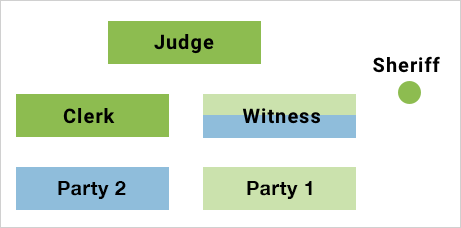Attend the hearing
You'll need:
- Your copy of your completed Application About a Protection Order (Form 12) and all supporting documents
- Notes you've made about the abuse
- Your witnesses, if you have them
At the hearing, you provide your evidence to the judge. Your evidence includes your application and spoken evidence that you promise is true.
If you don’t have a lawyer, you may find it helpful to have a trusted friend or family member with you to provide emotional support, take notes, and organize documents during your court appearance. See Can you take a support person to Provincial Court?.
Who is in the court
Here is a diagram of the interior of most Family Courts in British Columbia.
The people who'll be in the courtroom include:
- the judge, who hears the case and makes orders;
- the court clerk, who keeps the Family Court files, receives exhibits from witnesses (such as letters and documents), and operates the tape recorder that records all evidence given at trial;
- the sheriff, who pages witnesses who aren't in the courtroom and ensures that the courtroom remains a safe place;
- other people whose family court applications are on that day.
For an application for an urgent order without notice, you'll sit (at first) in the Party 1 area, but the person you're seeking protection from won't be in the Party 2 area. Your support person, if you have one, sits with you.
General guidelines
On the hearing date, arrive early and wear clean, conservative clothes. If you're bringing witnesses to court, make sure that they arrive on time and are also dressed in clean, conservative clothes.
Remember to bring your copy of your Application About a Protection Order (Form 12) and any other court documents, and any notes you have about the abuse by your partner.
Whenever you're speaking to a judge, remember to stand up. Speak in a loud, clear voice, and address the judge as ''Your Honour.'' Try to have a manner that is confident but also calm.
Duty counsel
There may be a family duty counsel lawyer in the courtroom on the day of your hearing. If you don't have your own lawyer, duty counsel may be able to speak on your behalf in court even if you didn't qualify for legal aid. If it's urgent, you can ask duty counsel for help if you've applied but not yet heard back from Legal Aid. Ask the registry staff if duty counsel is available on the day you have your hearing.
The court hearing
There'll be other people in the courtroom whose applications have also been scheduled for that day. Sit on the benches on the applicant side of the courtroom and wait for your name to be called. When your name is called, walk to the applicant table and introduce yourself to the judge.
When the judge asks you, tell the judge:
- you're asking for a protection order;
- that it's urgent; and
- that it's without notice.
For most protection order applications, the victim is the only witness. However, let the judge know if you've brought witnesses (people who'll speak under oath on your behalf). Your witnesses must have first-hand knowledge of the abuse. You can't have witnesses who'll just say things you told them about the abuse.
The judge will ask you to go into the witness box and either swear or affirm. You'll then tell your story to the judge, and give them the reasons why you want a protection order. The judge will ask you questions and expect you to tell your whole story. Be prepared to give details. It's okay to talk about how events made you feel (for example, very scared), as well as what actually happened.
If you have witnesses, they'll then have their turn in the witness box. Stand up when you're asking them questions.
Taking several slow, deep breaths can make you feel less tense.

